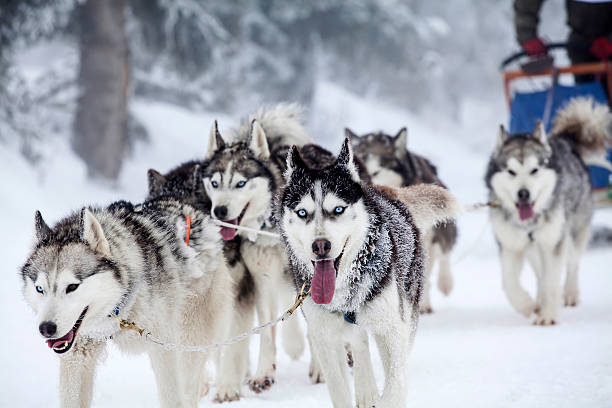Breeds, Training, and Their Global Use
Snow dogs, often referred to as sled dogs, are specialized breeds developed for work in cold and snowy environments. These dogs are renowned for their endurance, strength, and ability to thrive in harsh conditions. This article explores various snow dog breeds, their training methods, and their primary regions of use.
1. Breeds of Snow Dogs:
Siberian Husky:

The Siberian Husky is one of the most iconic snow dog breeds. Originating from Siberia, these dogs were bred by the Chukchi people for pulling sleds over long distances in freezing temperatures. They are known for their striking blue or multicolored eyes, thick double coat, and friendly disposition. Siberian Huskies are not only working dogs but also popular family pets due to their friendly nature.
Alaskan Malamute:

The Alaskan Malamute is one of the oldest and largest Arctic sled dog breeds. They were originally bred by the Inuit people of Alaska for hauling heavy loads over long distances. Malamutes have a strong, muscular build, a dense double coat, and a loyal, affectionate temperament. They are known for their endurance and strength, making them excellent sled dogs
Samoyed:

The Samoyed breed originates from Siberia, where they were used by the Samoyedic people for herding reindeer, pulling sleds, and keeping their owners warm. Samoyeds are easily recognizable by their fluffy white coat and characteristic “Sammy smile.” They are friendly, gentle, and highly social dogs, making them great companions as well as working dogs
Alaskan Husky:

The Alaskan Husky is not a pure breed but rather a category of sled dog. They are a mix of various Northern breeds and are specifically bred for their performance in sled racing and work. Alaskan Huskies are known for their speed, endurance, and excellent work ethic. They have a wide range of appearances but are typically lean and athletic
Greenland Dog:

The Greenland Dog is one of the oldest sled dog breeds, originating from the Arctic regions of Greenland. These dogs are strong, resilient, and have a thick double coat that protects them from extreme cold. Greenland Dogs are known for their loyalty and ability to work in harsh conditions, making them valuable for transportation and hunting
2. Training Snow Dogs:
Training snow dogs requires specialized techniques to ensure they are prepared for the demanding tasks of sled pulling and working in extreme conditions.
Basic Obedience Training:
Snow dogs must first learn basic obedience commands such as sit, stay, come, and heel. This foundation of obedience is crucial for ensuring control and communication between the handler and the dog.
Socialization:
Early socialization with people and other dogs is essential for snow dogs. It helps them develop good behavior, reduces fear and aggression, and ensures they are comfortable working in teams.
Introduction to Sleds:
Puppies are gradually introduced to the sled and harness. Initially, they may pull lightweight objects to get used to the sensation. This helps build their confidence and familiarity with the equipment.
Building Endurance and Strength:
Snow dogs need to develop their physical strength and endurance. Regular exercise, including long walks, runs, and gradually increasing sled pulling sessions, helps build their stamina and muscle strength.
Teamwork Training:
Snow dogs often work in teams, so they must learn to cooperate with other dogs. Training sessions include practicing commands that involve synchronized movements and following the lead dog’s direction.
Advanced Commands:
Specific sledding commands such as “hike” (go), “gee” (right), “haw” (left), and “whoa” (stop) are taught to snow dogs. These commands are essential for navigating trails and ensuring the safety of the team.
3. Where Snow Dogs Are Used Most:
Snow dogs are predominantly used in regions with cold climates and snowy conditions, where they play a crucial role in transportation, recreation, and traditional practices.
Alaska:
Alaska is famous for its sled dog culture, with events like the Iditarod Trail Sled Dog Race showcasing the prowess of snow dogs. Alaskan Malamutes, Siberian Huskies, and Alaskan Huskies are commonly used for both work and sport in this region.
Canada:
In Canada, particularly in the northern territories and provinces such as Yukon, Northwest Territories, and Nunavut, snow dogs are essential for transportation and traditional activities. They are used by indigenous communities for hunting, travel, and cultural practices.
Siberia:
Siberia, the homeland of the Siberian Husky and Samoyed, relies heavily on snow dogs for various tasks. These dogs are integral to the lifestyle of the indigenous people, providing transportation and companionship in one of the harshest climates on Earth.
Greenland:
The Greenland Dog is a vital part of Greenlandic culture, used for transportation, hunting, and traditional sled dog racing. These dogs are well-adapted to the extreme cold and are known for their strength and endurance.
Scandinavia:
In countries like Norway, Sweden, and Finland, snow dogs are used for recreational sledding and racing. The Sami people of Scandinavia have traditionally used breeds like the Samoyed for herding reindeer and pulling sleds.
